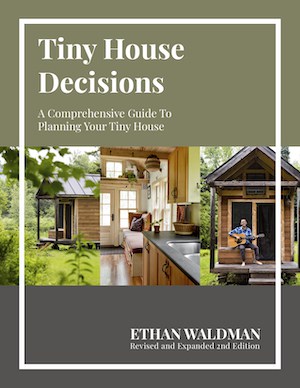Summer ends quickly here in Vermont. You go from wearing shorts and a t-shirt one day, to nights that dip down to 45 degrees and foggy, damp mornings the next. But it's not all bad.
Fall here is beautiful.

In fact, it's so beautiful that tourists come from all over the world to watch the changing of the leaves. We call them “leaf peepers”. Fall also signals a time of change. Animals prepare to hibernate or migrate. Our bees have collected all the nectar and pollen that they need for the winter [hopefully] and are shoring up the hive.
Fall is also a time for preparation at the tiny house
After fall comes winter, and winter is a particular challenge in a tiny house. So this fall, like the last three falls, I am preparing the tiny house for the winter to come.
How to prepare your tiny house for winter
That means three main areas:
- plumbing
- insulation
- systems
All three items are crucial to making sure the tiny house and all of its appliances weather the winter without undue stress or damage.
Winter plumbing in the tiny house
At my current location, I have a unique situation with the water that comes into the tiny house. Because the water comes from a spring which flows all the time, I created a loop of pipe that comes from the spring head and goes up the hill, underneath the tiny house, and then flows back down and drains into our pond.
Water that flows all the time in a pipe doesn't freeze, and this has proven true for the last three winters- polar vortexes and all! From this loop of pipe, there is a short length of hose that is plumbed into the tiny house. This means that you need to:
-Carefully check and test the heat tape that is wrapped around the water connection
Since the connection from my water loop to the tiny house will only flow while I'm running water in the tiny house, this section of hose needs to be heated with heat tape to prevent from freezing.
Winter plumbing inside the tiny house
On the inside of the house, most of the work is done during your initial build. Make sure you do your research and build a in a way that makes it possible to prepare your tiny house for winter.
The most important thing you can do to make your tiny house winter-resistant, is to choose a high quality (and high R-value) insulation. I went with spray foam because it seals the building cavity and acts as a vapor barrier.
As far as the plumbing goes, another important thing to do is to locate all of your plumbing on the inside of the insulation. In most typical homes, the plumbing is buried in the wall with insulation packed or sprayed around it. But in a tiny home with just 2×4 framed walls, I didn’t want to take the chance.
My plumbing is located on the inside of the walls and I’m glad it is- I’ve never had my interior plumbing freeze up.
On particularly cold nights, I’ll open the cabinets where the plumbing is located to make sure the warm air from my heater makes it inside the cabinet boxes. If you leave them closed it can get very chilly inside!
Insulating around the tiny house
As I have done in years past, I will insulate around my trailer with bales of hay wrapped in large contractor trash bags. The trash bags help keep the hay dry and prevent it from rotting too much. In years past, the hay has even been usable in the garden, compost, and around the property.
The contractor bags are a little annoying- when water drips off the roof and hits the bags, it makes a loud splat! But once the bags get covered with snow, the problem goes away. That's why I try to put up the hay insulation as late as possible.
Here's what that generally looks like:

this is winter from year 1, when i used mostly un-covered hay bales.
A special “systems” project
I have written extensively about the issue I have with my Hot Water Heater and the potential for damage during a long power outage.
Last winter I purchased a pricy Uninterruptable Power Supply in hopes that it would be able to power my propane detector and hot water heater through a long power outage. It proved not to last as long as my calculations told me it would, so this winter I am upgrading to a 125 amp-hour sealed battery.
I will power the HW heater and propane detector (both 12v appliances) directly from the battery which I will keep charged with an AC trickle charger. With the help of a electrically savvy friend, we determined that I’d get about 36 hours of backup power until the battery would be at 50%. I’m hopeful that this will solve my power outage issues once and for all!
Tiny House + Fall = Magic
Despite the long winter, I am grateful to live in Vermont where the seasons change so rapidly and with so much fanfare. To me, it makes the long winter worth it. If you take the time to prepare your tin house for winter, you won't have any problems.
Don’t believe me? Check out these photos that I snapped on my iPhone and tell me you don’t want to live here too!




